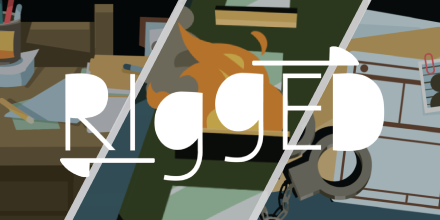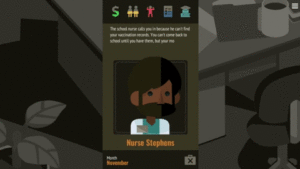 Last week, we released Rigged, a choose-your-own-adventure-style game designed to represent the experiences of youth trying to navigate school while experiencing challenges like homelessness, foster care placement, or incarceration. The game is a glimpse into the impossible tradeoffs these students face regularly.
Last week, we released Rigged, a choose-your-own-adventure-style game designed to represent the experiences of youth trying to navigate school while experiencing challenges like homelessness, foster care placement, or incarceration. The game is a glimpse into the impossible tradeoffs these students face regularly.
We collaborated with the folks at Filament Games, including the project’s sole engineer, Terra Lauterbach, to create this one-of-a-kind game. Terra has been a game engineer at Filament Games since early 2017, and for Rigged, she engineered the unique card-based mechanics and supported with the game’s user experience and sound design. I chatted with Terra to share more about the process of creating the game.
The interview below has been lightly edited for length and clarity.
What were the objectives in creating Rigged?
Rigged was envisioned as an interactive way to help players develop increased understanding and empathy towards underserved youth who have spent time in juvenile detention, are on parole, or may simply be struggling to navigate the system. Bellwether wanted players to be able to relate to the characters in the story, putting users in the shoes of underserved individuals in order to promote inclusivity and a greater shared perspective.
How did you approach designing a game around these topics?
We always intended for Rigged to be an open-ended experience. Our team wanted to give players a menu of choices and require them to balance the consequences of their decisions. Bellwether chose five in-game domains for the player to balance: money, relationships, health and wellness, academics, and responsibilities — all things that one must manage in day-to-day life. Each binary choice that the player faces has a non-binary effect on those domains, positively affecting some domains while negatively affecting others depending on what path the player chooses to follow. Having Bellwether’s subject matter experts easily available at all times (they created the actual content) was extremely useful throughout development.
Rigged features a card-based “swipe” control scheme. What was the inspiration behind this mechanic?
Our main inspiration was Reigns, a game where players similarly make binary choices that balance various “domains,” though obviously the subject matter and underlying themes of the two games couldn’t be more different. Having complex, open-ended choices that players must navigate in order to maintain domain balance makes for a really interesting narrative experience with lots of replayability. In some situations there really is no right answer — and this fact fits well with the content of the game, too.
Did working on the game change your perspective on these issues?
Many of Rigged’s characters, stories, and events are based off real-life accounts from underserved youth — so it was truly an authentic and immersive learning experience. What I found to be really eye-opening was learning about all the hardships that underserved youth face simply as a consequence of existing within the system. There are often many different points of contact that these youth must work with.
For instance, an individual may be required to attend scheduled meetings with a parole officer, but what happens when their check-in is scheduled during the same time as the only available meeting with their school counselor? These youth must balance so many priorities at once, often working with a multitude of individuals, each with competing interests. This was something I had never really thought much about prior to working on Rigged.
October 4, 2018
Behind the Scenes on Our New Education-Themed Web Game
By Bellwether

Share this article
More from this topic
Neurodiversity Celebration Month: A Mother-Daughter Conversation About Learning With ADHD
To Help Students Succeed, Let’s Make Boards Better
Tech Trend or Here to Stay? 7 Experts Anticipate AI’s Future in Education
No results found.